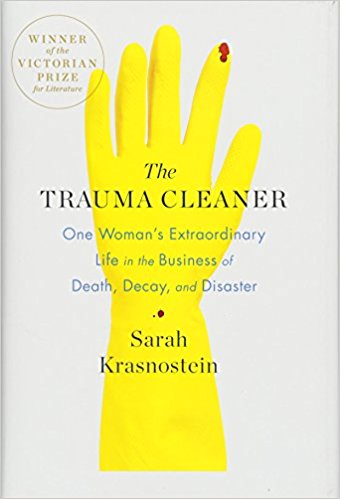Reviewed by Ashley Supinski
“Before she was a trauma cleaner, Sandra Pankhurst was many things: husband and father, drag queen, sex reassignment patient, sex worker, small businesswoman, trophy wife…But as a little boy, raised in violence and excluded from the family home, she just wanted to belong. Now she believes her clients deserve no less.” (book jacket)
 Sarah Krasnostein’s Trauma Cleaner: One Woman’s Extraordinary Life in the Business of Death, Decay, and Disaster (St. Martin’s Press, April 2018) is a love story to its central figure, Sandra Pankhurst.
Sarah Krasnostein’s Trauma Cleaner: One Woman’s Extraordinary Life in the Business of Death, Decay, and Disaster (St. Martin’s Press, April 2018) is a love story to its central figure, Sandra Pankhurst.
Pankhurst, now in her sixties, doesn’t remember much of her earlier life. Though this would make her an unreliable narrator in any other story, Krasnostein has worked diligently to be both biographer and researcher and give Pankhurst her history back. This “biography” is more than just the story of a woman with an extraordinary job—it is about claiming a personal history and embracing the trauma that the woman survived, while giving others the same dignity and respect in her current career as a trauma cleaner, someone who is called in to clean a residence in the aftermath of a murder, suicide, or obscene hoarding.
Trauma Cleaner is part-memoir, part-biography, all character study. Beyond Pankhurst’s own story, Krasnostein briefly relays the history of transgender peoples of Australia during the 70s and 80s, when they were at risk for unprovoked beatings by police and shunning from society. This is Sandra’s story, to be sure, but it is also a story of death and rebirth. It is the story of survival through the act of physically purging garbage.
Krasnostein tells of both Sandra’s life in Australia from a traumatic, abuse-filled childhood, where she was abused regularly and eventually thrown out of the house by the age of 17, to the present, where Sandra lives with lung and liver diseases, running a successful business, and trying to reconnect with the son she left.
The alternating chapters show Pankhurst at work. These chapters are named by the clients Sandra is helping to get back on their feet, by cleaning their houses and putting them back into order. These clients are often older, live alone, and hoarders of a great variety. They have lived through their own traumas, which have manifested in garbage that climbs the walls, and dirty dishes that breed mold. Through these chapters, Krasnostein is able to give Pankhurst’s life more vividness. Here, we see the way Sandra deals with her clients, in a soft, reassuring tone. She cracks jokes while cleaning piles of mail next to a woman’s bed. She muses about framing a wall-sized mural to frowning over rotted floorboards. She has given these people—who society would deem inappropriate—life and respect once again. And in doing so, Pankhurst has also worked through her own personal traumas.
The biography is highly recommended for anyone who’s interested in LGBTQ+ history, and also those surviving trauma.


